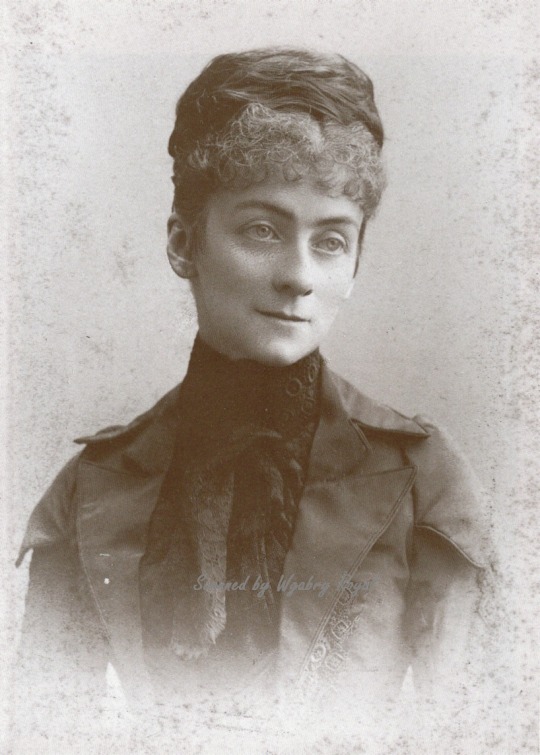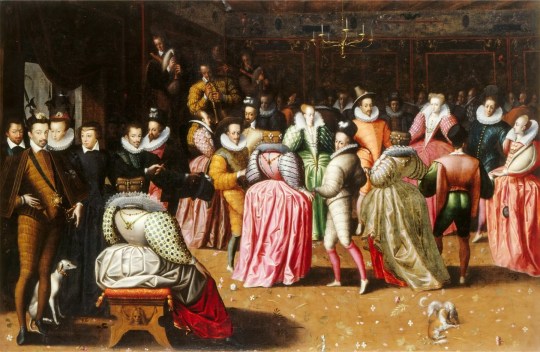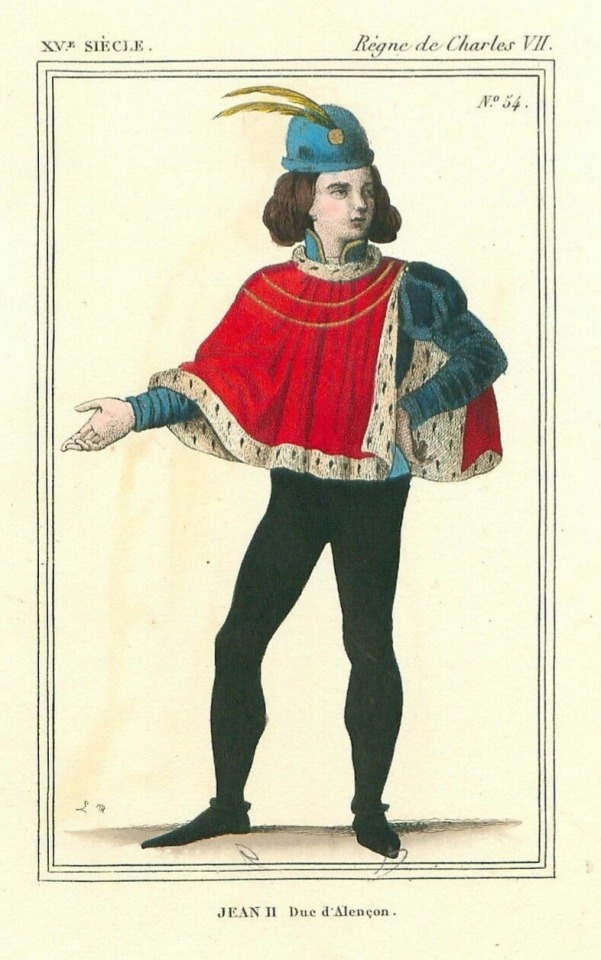#duc d'Alençon
Explore tagged Tumblr posts
Text

René de Valois (1454-1492), duc d'Alençon de 1476 à 1492. Auteur inconnu.
#Auteur inconnu#royaume de france#maison de valois#duc d'Alençon#Valois Alençon#rené de valois#engraving#prince du sang#kingdom of france#house of valois#in armour
7 notes
·
View notes
Text

1566-1567 Workshop of François Clouet - François-Hercule de France, duc d'Alençon
(Louvre Museum)
94 notes
·
View notes
Text

Duchess Sophie Charlotte Augustine in Bavaria wife of Ferdinand Philippe Marie d'Orléans, duc d'Alençon
Source "Das Familienalbum von Kaiser Franz Joseph und Elisabeth"
17 notes
·
View notes
Text

French School • Ball at the court of Henry III, Duc d'Alençon • 2nd half of the 16th century •
Bombastic ball!
The puffy sleeves of the Elizabethan era were not that way due to starch or stiff fabric. It was stuffing! And it wasn’t light and airy, either. Men and women would stuff their sleeves with rags, cotton, horsehair, and even bran. The trend went beyond sleeves, too. Men would also stuff their doublets so they could give themselves a larger belly – a symbol of wealth. This practice inspired the adjective “bombastic.” Then, bombastic referred to clothes stuffing. Today bombastic is a word used to describe someone who is pompous and exagerates his/her/their worth and accomplishments.
#french school#genre scene#french royalty#the resplendent outfit#bombastic sleeves#16th century fashion#16th century#painting#old paintings#fashion history
24 notes
·
View notes
Photo

"Bal à la Cour d'Henri III" ou "Bal du Duc d'Alençon" (détail) anonyme (circa 1580) présenté à la conférence “S'Habiller à la Renaissance” par Marine Chaleroux - Historienne d'Art - de l'association Des Mots et Des Arts, avril 2023.
2 notes
·
View notes
Text





I completely forgot about it
#elizabeth i#queen of england#renaissance#valois#françois de france#duc d'alençon#16th century#history memes#history#the tudors#tudor dynasty#tudor memes#tudor england
8 notes
·
View notes
Photo
He was the second son of Prince Louis d'Orléans, Duke of Nemours, and his wife, Princess Victoria of Saxe-Coburg-Kohary.

Prince Ferdinand d´Orleans, Duc d Alencon. Early 1870s.
#royaume de france#maison d'orleans#bourbon orleans#maison d'orléans#ferdinand d'orléans#duc d'alençon#nemours
35 notes
·
View notes
Note
Top 5 temas de tu final (ahre), top 5 historical blorbos, top 5 películas en blanco y negro (pueden ser talkies). Top 5 especias
dskljfkldsjdfkl por qué me odiás.
temas de mi final 5. inquisición 4. derechos bizarros 3. caza de brujas 2. guerras de religión catalina de medici like i love all my children equally i dont care for hercule françois duc d'alençon et d'anjou 1. anabaptismo + guerras campesinas müntzer enfermo de mierda my beloved
historical blorbos 5. ahora mismo estoy muy en un momento de blorborizar a françois d'alençon perdón 4. jesús de nazareth (OR IS HE) 3. amílcar cabral 2. radowitzky my beloved 1. ROBESPIERRE MI NIÑO BONITO MI DULCE PRINCESO pelis en blanco y negro 5. La Règle du jeu 4. Ascenseur pour l'échafau 3. metropolis 2. Le doulos mr belmondo pls. 1. ��етят журавли i love this movie with all my heart and soul
especias uf una fácil 5. cúrcuma 4. pimentón 3. canela 2. locoto 1. curry
7 notes
·
View notes
Text
The other day I had an ask about Sophie's marriage to Ferdinand d'Orléans. In the answer I quoted a fragment of an account of the wedding by Prince Hohenlohe-Schilling, which in turn was quoted in Erika Bestenreiner's book about Elisabeth and her siblings. Well I should have digged a bit deeper because it turns out that the Prince's memoirs from which said quote comes from had been translated to English, so we actually have his full account of the celebrations. You can read the whole thing here, which includes tons of biased descriptions of several of the royal guests, but also really bad smell in your guest room, someone looking at you like if you were a scorpion and a mediocre perfomance of one of Verdi's operas during Mass.
STARNBERG, September 28, 1868.
In obedience to the Royal command I came to this place to attend, as Minister of the Household, the marriage of the Duchess Sophie with the Duc d'Alençon, son of the Duc de Nemours. Prince Adalbert and Minister Pfretzschner were appointed to act as witnesses. As the latter preferred to spend the night at Starnberg, I decided to leave yesterday afternoon at half-past two. We arrived at four o'clock, took possession of our rooms at the Hotel am See, and then took a walk, dined at five o'clock and then went down again to the shore of the lake in hopes of seeing something of the illuminations which were to take place nominally in honour of the Czarina of Russia then staying at Berg. But it was nine o'clock, and as nothing happened we preferred not to wait about any longer, and soon got to bed. The fireworks and illuminations would seem to have been very fine, but very little could be seen here. It was Sunday, and consequently a numerous and beery contingent of the general public had taken post under our windows, and kept up a horrible din and shouting. At intervals they sang ''popular airs," but these almost immediately degenerated into mere brutish yells. However, I soon fell asleep, especially as a wholesome storm of rain dispersed the gang. This morning I went to the railway station to see the Empress of Russia depart. Tauffkirchen* was there too, to pay his respects to the Empress. The King accompanied the Empress and travelled some distance with her on the railway in the direction of Munich, but I do not know how far.
At ten we drove over to Possenhofen in my carriage, which I had had brought here yesterday. It was not eleven o'clock yet, so we were taken first to our rooms. In mine there was a villainous bad smell. Soon the time for the wedding ceremony arrived, which took place in a hall of the Castle transformed into a chapel. The guests assembled in the adjoining salon, where a grand piano further blocked the scanty space available. Pfretzschner and I hastened to get ourselves presented to all personages of rank. Besides the family of the Duke Max, Prince Adalbert and Prince Karl were there. The latter bowed to me across the room with a look such as one generally bestows upon a scorpion. Then Count and Countess Trani. The Hereditary Princess Taxis wore a mauve or violet dress trimmed with white. Others present were the Comte de Paris and his brother, the Duc de Chartres, two young and well-built princes, but who give the impression rather of Prussian than of French princes. The Duc de Nemours looked like a French dandy from the Cercle de l'Union. He wore the Order of St. Hubert, as did his son, the bridegroom. The Duc de Nemours recalls the portraits of Henri IV., yet he has a certain look of his own that makes you set him down as a pedant. The young Duc d'Alençon is a handsome young man of a fresh countenance. The Prince de Joinville and his son, the Duc de Penthièvre, have nothing very striking about them. The former is old-looking and bent, too old-looking for his age, dignified and courtly. The Duc de Penthièvre has a yellow, rather Jewish face, and speaks with a drawl, but was very kind and friendly to me. Duke August of Coburg is as tedious as ever. I was interested to become acquainted with his wife, the Princess Clementine, a clever, lively woman. The Princess Joinville, a Brazilian Princess, is rather mummified, with big rolling eyes in a long, pale, wrinkled face. Then there were two daughters of Nemours there too, one grown up, the other a little girl. The ladies were all in "high dresses." The bride in white silk, trimmed with orange blossom, with head-dress of orange blossom and a tulle veil. On the sleeves braids of satin, after the pattern of the Lifeguardsmen's stripes. A lady-in-waiting attached to the Nemours party wore a flame-coloured silk with straw-coloured trimmings. When all were assembled, we proceeded to the chapel. The bridal couple knelt before the altar. Behind them, on the left, Prince Adalbert, behind him we two Ministers, and then behind us the gentlemen of the House of Orleans. On the other side the Duc de Nemours and the Duchess, likewise all the Princesses. Hancberg began the ceremony with a suitable address. Nobody cried, but Duke Max looked rather like it once or twice. The bride appeared extremely self-possessed. Before the "affirmation" the bridegroom first made a bow to his father, and the bride did the same to her parents. The Duchess's "Yes" sounded very much as if she meant "Yes, for my own part," or "For aught I care." I don't wish to be spiteful, but it sounded like that to me. After the wedding, I kissed the Duchess's hand, and congratulated her. She seemed highly gratified and pleased. The pause between the wedding ceremony and the State dinner we spent in our room. I forgot, by-the-by, to say that during the Mass a military band played an accompaniment to the religious ceremony. It began with the overture to one of Verdi's operas, I don't know whether it was Traviata or Trovatore. It was but a mediocre performance, the sort of stuff you hear played at dinners.
The State dinner was held downstairs in two halls. In one sat all Royal personages and myself along with Pfretzchner, in the other the courtiers. The health of the bridal pair was drunk without speechmaking. I sat between the young Princess of Coburg and Duke Ludwig. The dinner was not particularly long, nor was it particularly good either. On rising from table there was some more standing about, and then all the company separated. The Orleans Princes took their departure at once, about half-past four, as did the other Princes. Only the Duc de Nemours stays on till the day after tomorrow with his children.
We drove back to Starnberg in one of the Ducal carriages, from whence we return to-day to Munich by the eight o'clock train.
At dinner the "Wedding Chorus" from Lohengrin was played. It must have been singularly agreeable to the King's ex-fiancée. Another odd coincidence was that the very evening before, the lake and mountains were illuminated (for the Czarina), and the King had to celebrate in this way his erstwhile fiancée's bridal eve.
The Comte de Paris spoke to me about war and peace, and maintains that popular feeling in France is opposed to war. But he said it was difficult to gauge public opinion in France, the Press is so wanting in independence.
He is a sensible, well-meaning man, who would make an excellent Constitutional King of France.
*Count Tauffkirchen was at that time Bavarian Minister at St Petersburg.
#chlodwig prince of hohenlohe-schilling#sophie in bavaria duchesse d'alençon#ferdinand d'orléans duke of alençon#prince louis d'orléans duke of nemours#and many more!#memoirs of prince chlowdig of hohenlohe-schillingsfuerst#house of wittelsbach#house of orléans
6 notes
·
View notes
Note
Have you ever thought about drawing or making a comic about La Hire?
Ahhh, La Hire, (Étienne de Vignoles) one of Joan's comrades.
An interesting guy to think of, according to the descriptions (left by Dunois himself) he was a big and tough guy, with a strong accent of Gascogne (Gascony) and a short temper who swore a lot. However, he was really loyal to Joan until his own death.
I discussed this matter with @littlewitty who, I'm sure of it, finds this guy amusing too.
Now the problem is, should I include him in my comics ?
I would love to, really. But I have to think of his chara design, and I picture him with a beard.
But I suck at drawing beards AND tough guys.
So I'm still trying to find a way, because La Hire was older than Jean's crew.
So it's a maybe. I want to, but I need to work on it.
For now I drew :
Gilles de Rais
Jean II, Duc d'Alençon
Jean le Bâtard d'Orléans, count of Dunois + Marie d'Harcourt, his wife
Florent d'Illiers
Jean d'Arc
Pierre d'Arc
32 notes
·
View notes
Text

Jean II d'Alençon (1409-1476), duke of Alençon, count of Perche, son of Jean I and Marie de Bretagne, daughter of duke Jean IV, was a French blood prince and warlord of the 15th century and companion in arms of Joan of Arc.
#maison d'Alençon#royaume de france#full-length portrait#maison de valois#full length portrait#la guerre des cent ans#duc d'alençon
5 notes
·
View notes
Photo

Artista: Francés del siglo XVII
Título: Hercule-François, 1544-1584, Duc d'Alençon y d'Anjou [anverso]
Con fecha de siglo XVII
Clasificación: Escultura
Medio: bronce
Dimensiones (diámetro) total: 3,57 cm, de peso bruto: 21,81 gr, eje: 12:00
Crédito: Regalo de Lisa y Leonard Baskin
Información de la National Gallery of Art.
17 notes
·
View notes
Photo

Emmanuel d'Orléans duc de Vendôme et d'Alençon. He was the second child and only son of Ferdinand Philippe d'Orléans, Duke of Alençon and his wife Duchess Sophie Charlotte in Bavaria.
14 notes
·
View notes
Quote
- Mon cher, répondit Coconnas, écoute bien ce que je vais te dire et tâche d'en faire ton profit. Dans toutes ces menées princières, dans toutes ces machinations royales, nous ne pouvons et surtout nous ne devons passer que comme des ombres: où le roi de Navarre laissera un morceau de sa plume, et le duc d'Alençon un pan de son manteau, nous laisserons notre vie, nous. Perds la tête en amour, mon cher, mais ne la perds pas en politique.
La Reine Margot, Alexandre Dumas
6 notes
·
View notes
Photo

Prince Hercule-François, Duc d'Alençon, 1572, National Gallery of Art, Washington, D.C. INSCRIPTION upper left: . FRANCOIS . DVC . DALENCON . / . EAGE . DE . XVIII . ANS LE.XIX.E / . IONR . DE . MARS . AN . 1572 . / . FILS . DE . HENRY II.EDE CE . / NO M . ROY . DE . FRANCE . Source: https://www.nga.gov/content/ngaweb/Collection/art-object-page.46154.html#history
14 notes
·
View notes
Text
@louisoffrance ; lakes of bellinzona.
“ monsieur le duc d'alençon, ” she greets with a fleeting smile and warmth in her voice, thinking how much has changed since their initial meeting in the ballroom of montebello. “ i am glad to see you well, and my condolences for the loss of the viscount. jacques, yes? ” her well-wishes are nothing short of genuine; she could be quick to point fingers at the ottomans and their allies, but they, too, have suffered losses, and was not france once a catholic country? call her naive, but there is strength in kindness when an unknown hand wishes to sow only discord. she wants justice, yes, for her family and her country, but she will still extend an olive branch to those who will take it. perhaps she can find a middle ground this way.
casting a glance towards the portuguese guard standing not too far from where she sits beneath a tree, she snaps her book shut with a small, frustrated sigh. “ do you think, ” she begins, “ i am courting danger by reading by the lake? or should i be cowering in my rooms, waiting with bated breath for the next blow to befall us? ” because louis happens to be here, he has become the poor, unsuspecting target of her jumbled thoughts. what good is hiding when the duke of milan was killed at his desk? “ my ladies certainly think i should be coddled and protected, but staying still i cannot do. ”

1 note
·
View note